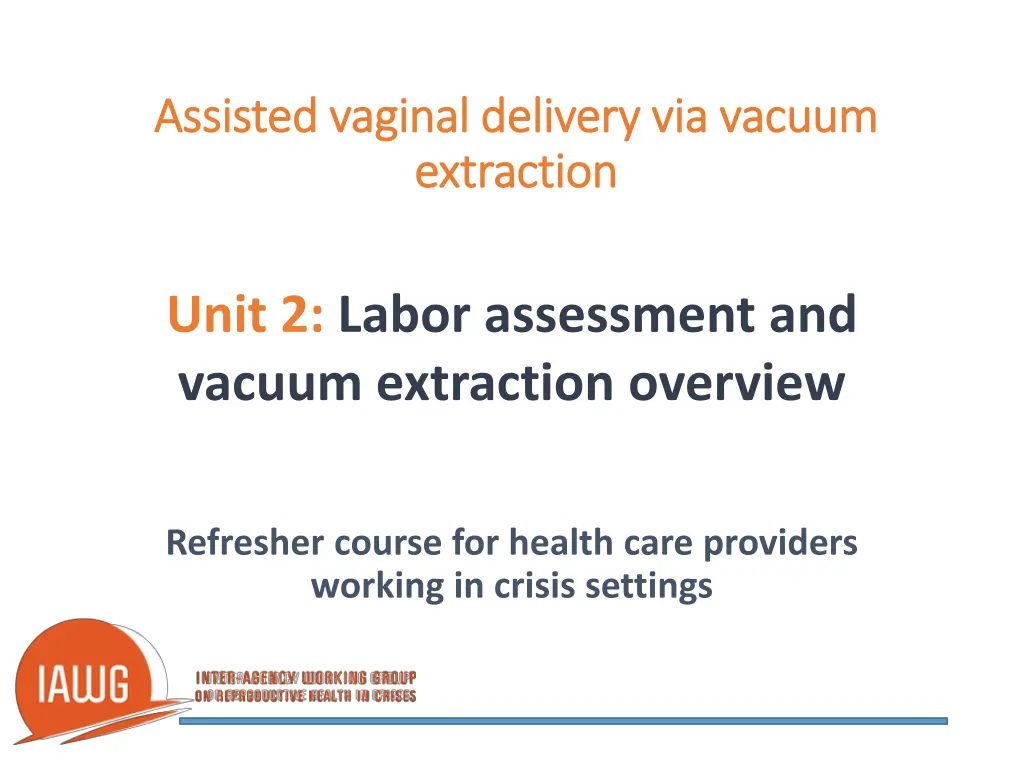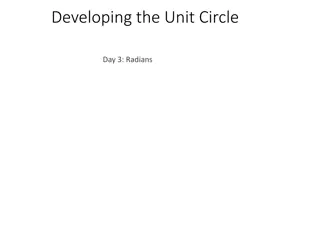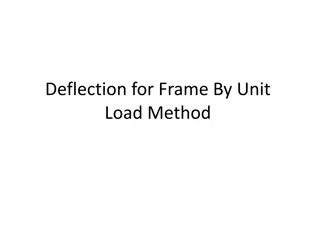
Assisted Vaginal Delivery and Emergency Obstetric Care Overview
Learn about assisted vaginal delivery via vacuum extraction, the importance of emergency obstetric care, and the key considerations when assessing a laboring woman in distress. Understand the background statistics, signal functions, and historical aspects related to maternal and neonatal care.
Download Presentation

Please find below an Image/Link to download the presentation.
The content on the website is provided AS IS for your information and personal use only. It may not be sold, licensed, or shared on other websites without obtaining consent from the author. If you encounter any issues during the download, it is possible that the publisher has removed the file from their server.
You are allowed to download the files provided on this website for personal or commercial use, subject to the condition that they are used lawfully. All files are the property of their respective owners.
The content on the website is provided AS IS for your information and personal use only. It may not be sold, licensed, or shared on other websites without obtaining consent from the author.
E N D
Presentation Transcript
Assisted vaginal delivery via vacuum Assisted vaginal delivery via vacuum extraction extraction Unit 2:Labor assessment and vacuum extraction overview Refresher course for health care providers working in crisis settings
Background Background In a displaced population, approx. 4% of total population will be pregnant at any given time Maternal deaths: Estimated 289,000 in 2013 Lifetime risk of maternal death: Sub-Saharan Africa: 1 in 38 Oceania: 1 in 140 (PNG 1:35) Southern Asia: 1 in 200 North America: 1 in 10,000 61% of maternal deaths occur in fragile states, many of them affected by conflict and recurring natural disasters
Background Background Approximately 15% of pregnancies have an obstetric complication at the time of birth Approximately 8% of all maternal deaths are caused by obstructed labor 9-33/1000 babies die in the early neonatal period 25% of birth asphyxia Assisted vaginal delivery can avert maternal and perinatal morbidity and mortality
Signal functions of basic emergency Signal functions of basic emergency obstetric and newborn care obstetric and newborn care COMPREHENSIVE EmONC BASIC EmONC 1. Antibiotics IV/IM 8. Surgery, including cesarean section (CS) 2. 2. Oxytocic drugs IV/IM Oxytocic Drugs IV/IM 9. Blood transfusion 3. Anticonvulsants IV/IM 4. Manual removal of placenta 5. Manual vacuum aspiration of retained products of conception 6. 6. Vacuum extraction Vacuum extraction 7. Newborn resuscitation
A laboring woman is in distress and A laboring woman is in distress and you ve been called to assess her: you ve been called to assess her: Check: 1. The status of the mother and the baby. 2. Are there signs of obstructed labor? 3. Is there an indication for vacuum extraction? 4. Is it a safe procedure to perform? 5. Is the proper equipment available? 6. Does the mother understands how you will help her?
History History Always check the history of the patient first Prior cesarean section? Prior vacuum? Health issues? Greet and reassure the patient, discuss why she has come for care Check the partogram for progress and observations; particularly the progress of the 2nd stage so far Provide compassionate care be nice
Partogram Partogram
Partogram Partogram
Physical Exam Physical Exam Contractions: frequency and duration Normal contractions in the active phase of labor have a frequency of 3 in 10 minutes lasting for 45 seconds. Inadequate contractions should be stimulated/augmented with oxytocin infusion before vacuum extraction procedure is commenced. Abdominal examination Fundal height in cm Presenting part and level of the fetal head Fetal heartbeat Estimated size of baby Estimated amount of fluid Pelvic examination Cervical dilatation Cervical effacement & application to presenting part Fetal head position and flexion Presence of caput and molding Cervical edema Descent/dilatation with and without a contraction Any signs of Obstructed Labor, Vulval edema, Bandyl s ring, active phase of labor more than 20 hours
Physical exam Physical exam Abdominal palpation for level of the head 0/5 Mola, G., Ed. 2010. Manual of Standard Managements in Obstetrics and Gynecology for Doctors, HEOs and Nurses in Papua New Guinea. 6th Edition
Physical exam Physical exam Degree of molding Mild (+) Moderate (++) Severe (+++) Difficulty of vacuum extraction increases with amount of molding Vacca, A. 2009. Handbook of Vacuum Delivery in Obstetric Practice. 3rd Ed. Vacca Research.
A laboring woman is in distress and A laboring woman is in distress and you ve been called to assess her: you ve been called to assess her: Check: 1. The status of the mother and the baby 2. Are there signs of obstructed labor? 3. Is there an indication for vacuum extraction? 4. Is it a safe procedure to perform? 5. Is the proper equipment available? 6. Does the mother understands how you will help her?
Activity Activity Divide into pairs Answer: What causes unsatisfactory progress of labor? What is the risk to the mother and baby? What are possible interventions? What promotes normal progress of labor?
Unsatisfactory progress of labor Irregular and weak Contractions False labor Inadequate uterine activity Cervix 4 cm 10 cm (Latent ) (Active) (expulsive) Regular and strong Prolonged labour Latent phase (cervical dilatation < 4cm, > 8 hrs) Active phase (cervical dilatation 4 10 cm, > 12 hrs) Expulsive phase Contractions 14
Prolonged labor Prolonged labor Inadequate uterine activity Malpresentation or malposition Cephalopelvic disproportion (CPD) A misfit between the fetal head and the pelvis True or relative Obstructed labor Insurmountable barrier preventing fetal descent Secondary arrest of dilatation and descent of presenting part, with large caput and molding +++
Assessment of your findings Assessment of your findings Is labor obstructed? Yes if: How long she has been in labor? >20 - 24hrs? Check for signs of obstruction How long have the membranes been ruptured in the ACTIVE phase of labor? > 12 hours? How long has she been pushing? > 2-3 hours What are the contractions like? *In a primigravida, there is often secondary uterine inertia (i.e. the contractions were strong but have now become weak) 2-3 / 10 min* Is there 1. vulvar edema 2. severe molding of the head 3. 2-3/5th head still above the brim 4. Bandyl s ring after drainage of bladder 5. hematuria 1. Yes 2. Yes 3. Yes 4. Yes 5. Yes
Physical exam Physical exam Signs of obstruction Vulvar edema Hematuria Images used with permission of Dr. Glen Mola
Physical exam Physical exam Bandl s ring Catheterize to empty the bladder. Leave catheter in place for transfer. Do not perform vacuum extraction unless the head is on the perineum. Refer urgently for cesarean section or perforate the fetal head if the baby is dead. Used with permission of Dr. Glen Mola
Plan if labor is obstructed: Plan if labor is obstructed: Ring for advice if possible Prepare for transfer for CS Explain to patient and family IV hydration Antibiotics if fever or membranes ruptured >18 hours Analgesia if available Transport in left side-lying position
Physical exam Physical exam Check the fetal heart. Is the baby still alive? If the baby has died and labor is obstructed, then it is important to perforate the fetal head as soon as possible to prevent maternal complications (i.e. maternal death from ruptured uterus or obstetrical fistula formation)
Plan if the baby has died: Plan if the baby has died: Expedite delivery in the health center unless the patient can be immediately transferred to a higher level of care within an hour. Delay in helping the woman deliver can lead to maternal death from uterine rupture or permanent disability from obstetric fistula.
To perforate To perforate the skull: the skull: 1. Make 1. Make an incision an incision by pushing by pushing sharp scissors into scissors into the dead fetus head dead fetus head and opening and opening and closing closing them widely them widely a few times. a few times. 1 sharp the and 2 Used with permission of Dr. Miriam O Connor, FRANZCOG
2. 2. Rotate the open Rotate the open scissors 90 scissors 90o o, and open and close a open and close a few times . few times . , and Used with permission of Dr. Glen Mola
3. Grasp the fetal skull 3. Grasp the fetal skull (sides of the hole you (sides of the hole you have made) with have made) with toothed grasping toothed grasping- - forceps ( forceps (volsellum volsellum, , tenaculum tenaculum, , Kochers Kochers) ) 4. Apply traction during 4. Apply traction during a contraction with the a contraction with the woman s pushing efforts woman s pushing efforts Used with permission of Dr. Glen Mola
A laboring woman is in distress and A laboring woman is in distress and you ve been called to assess her: you ve been called to assess her: Check: 1. The status of the mother and the baby 2. Are there signs of obstructed labor? 3. Is there an indication for vacuum extraction? 4. Is it a safe procedure to perform? 5. Is the proper equipment available? 6. Does the mother understand how you will help her?
Plan if prolonged labor: Plan if prolonged labor: Possible interventions depend on stage, cause, and condition of woman and fetus Supportive care Labor augmentation: oxytocic drug Assisted vaginal delivery: vacuum extraction Symphysiotomy Cesarean section (CS)
Plan if prolonged labor: Plan if prolonged labor: Supportive care: Correct the correctable Hydration? Upright position? Full bladder? Does the woman understand what is happening? Is the baby ok? Contracting ok? Urgency to deliver right now or not? Can I safely take time to deal with these?
Plan if prolonged labor: Plan if prolonged labor: Labor augmentation If the cervix is not dilating at 1 cm per hour, (i.e. partograph crossing action line), and There are no signs of obstructed labor Use oxytocic drug 2.5 units in 500 mL of normal saline, begin at 10 drops/minute Increase by 10 drops/minute every 30 minutes until good contractions (frequency 3 in 10 and duration of > 45 seconds) Exercise extreme caution with oxytocin: Risk of uterine hyperstimulation causing uterine rupture or fetal distress
Plan if prolonged labor: Plan if prolonged labor: Assisted vaginal birth: Vacuum-assisted or vacuum extraction (VE) Forceps delivery is NOT recommended Vacuum extraction cannot solve all causes of prolonged labor Access to CS or symphysiotomy is essential in case of failed attempt of vacuum extraction
Why is it so important to Why is it so important to keep the CS rate down keep the CS rate down? ? The risk of dying is greater with a CS than a vaginal birth in low-resource settings It is not possible to manage the longer term problems: increased risk of uterine rupture, placental implantation abnormalities (i.e. placenta previa percreta) For the next pregnancy there is often: No antenatal care No supervised labor and delivery No blood transfusion No anything available or accessible next time Then CS for this delivery will be VERY dangerous for the woman's future.
Vacuum Vacuum- -assisted birth assisted birth Is designed to produce traction upon the fetal scalp and thereby Assists maternal expulsive efforts so that the mother can deliver vaginally Can assist the fetal head to flex so that autorotation can occur to facilitate vaginal birth, even when there is a malpresentation of the occiput Can fail to deliver the fetus, especially if the rules of the procedure are not followed
Indications Indications Fetal Distress in second stage of labor that requires immediate delivery Fetal heart rate <100 or >180 bpm Thick green or black meconium in fluid
Indications Indications Maternal Failure to deliver spontaneously after appropriate 2nd stage management Need to shorten 2nd stage or pushing is contraindicated (maternal medical condition) Maternal exhaustion There are no absolute indications. Always consider on a case-by-case basis.
A laboring woman is in distress and A laboring woman is in distress and you ve been called to assess her: you ve been called to assess her: Check: 1. The status of the mother and the baby 2. Are there signs of obstructed labor? 3. Is there an indication for vacuum extraction? 4. Is it a safe procedure to perform? 5. Is the proper equipment available? 6. Does the mother understand how you will help her?
Prerequisites Prerequisites What are the prerequisites for vacuum extraction? Is the procedure safe to do at your facility with the present human resources?
Prerequisites Prerequisites Exclude signs of obstruction Appropriate indication: maternal or fetal Adequate contraction pattern At least 3 in 10 minutes, lasting at least 45 seconds Vertex presentation, at least 0 station No head palpable above the symphysis pubis Fetus at least 34 weeks gestation Cervix fully dilated
Prerequisites Prerequisites Ruptured membranes Empty maternal bladder, catheter if needed Appropriate analgesia, as required usually, a local in the perineum is only needed Informed consent Knowledgeable healthn care provider Competent in vacuum-assisted birth Instrument, its use, possible complications Adequate facilities and back-up available
Absolute contraindications Absolute contraindications Non-vertex presentation (breech, face, brow) Unengaged vertex (i.e. more than 1/5 of head above the brim of the pelvis unless you specifically set the procedure up as a trial with capacity to proceed straight to CS or symphysiotomy if the trial fails) Incompletely dilated cervix (other than an anterior lip that you can push back to apply the cup) Obstructed labor (unless the head is on the perineum)
Relative contraindications Relative contraindications Mid-pelvic station (1-2/5 of head still palpable above the brim of the pelvis) < 34 weeks gestation Competence of provider (inexperienced provider should only attempt the most straightforward and simple procedures) Availability of referral facility or senior person to provide backup
A laboring woman is in distress and A laboring woman is in distress and you ve been called to assess her: you ve been called to assess her: Check: 1. The status of the mother and the baby 2. Are there signs of obstructed labor? 3. Is there an indication for vacuum extraction? 4. Is it a safe procedure to perform? 5. Is the proper equipment available? 6. Does the mother understand how you will help her?
Equipment Equipment Conventional VE Assistant creates vacuum manually Single operator cup Narang Medical LTD
Slide cups Slide cups Metal or plastic hard cups are included in the Inter-agency RH kits. The metal cup on the extreme left is an obsolete Malmstrom cup from the 1950s and has been superceded by cup that can be more easily placed over the flexion point (i.e. Bird anterior a posterior cups)






















